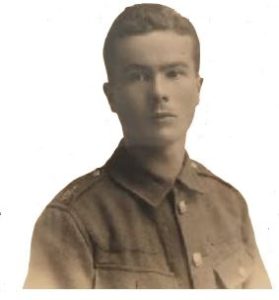1/14th Battalion, London Regiment (London Scottish)

William Harkness Evans was born at Bradley, near Ashbourne, Derbyshire on 20 April 1897. At the time of the 1911 Census his family lived at The Verlands, Upton Lane, Gloucester and his father was the headmaster at Barnwood School.
Aged ten he headed the scholarship list for Gloucester and was educated at Sir Thomas Rich’s School. He left at the age of fifteen, joined the staff of Barclays Bank and was posted to their Walthamstow Branch in east London. He became a member of the Institute of Bankers and passed their qualification examinations.
He attested for military service under ‘Lord Derby’s Scheme’ on 3 December 1918 at the age of 18 years and seven months but was not mobilised until 29 April 1916, when he was aged 19. His posting was to the 1/14th (Territorial Force) Battalion of the London Regiment, better known as the London Scottish and was allocated the number In 1917 this was changed to 513580, when all serving Territorial Force personnel received a new six digit number.
After summer months in training, he arrived on the Western Front on 7 September 1916 and soon joined the London Scottish in the field. He saw action at Angle Wood, near Guillemont and at Bouleaux and Leuze Wood.
On 31 October 1916 William was wounded in the head (over the right eye) and the right knee at Fauquissart, a village between Laventie and Neuve-Chapelle and was admitted to hospital.
He had recovered from his wounds by April 1917 and saw action in the Battle of Arras, when his battalion, part of 56th Division, attacked the Hindenburg Line south east of Arras, at Neuville Vitasse.
Later that year the London Scottish was located in the Ypres Salient. According to its war diary, on 16 August the battalion was located near Zillebek and eleven other ranks were killed and ten wounded when a heavy shell fell on a battalion carrying party. William reportedly suffered
fourteen wounds to the head, both legs and arms: a piece of shrapnel had penetrated his skull.
After a period in hospital at Rouen he returned to England on 7 October 1917; initially to a hospital in Lancashire and latterly to the Red Cross Hospital in Gloucester.
He was discharged from the Army on 20 December 1918, as no longer fit for service. He remained in a poor condition and gradually deteriorated. He collapsed on 10 January 1919 and was rushed to the Red Cross Hospital for an emergency operation, following which he died the following day, aged 21.
His funeral took place at Barnwood Parish Church on 15 January and he was buried in the churchyard where a standard CWGC headstone marks his grave.
His Serjeant wrote of him:
‘He was a true man both in and out of the line – one whom I always selected for the most trying work. His comrades loved him, while I relied upon him. It will be difficult to find his equal’
